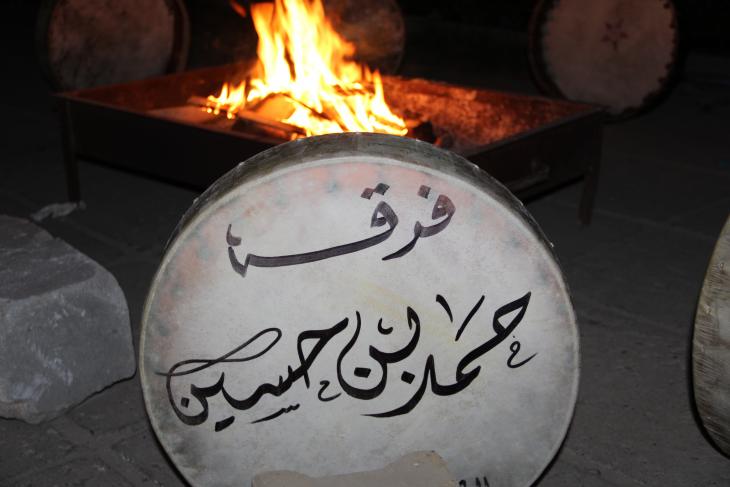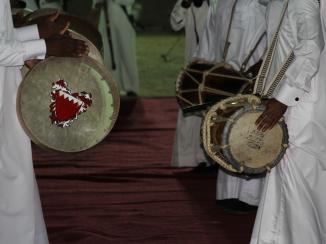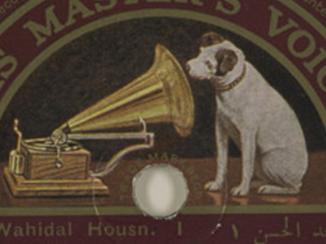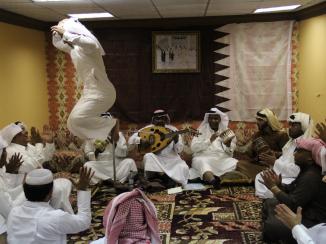Overview
There is no better way to describe the fann al baḥri (“the art of the sea”) than what the explorer and writer The lowest of the four classes into which East India Company civil servants were divided. A Writer’s duties originally consisted mostly of copying documents and book-keeping. Alan Villiers did on a Kuwaiti trading ship in 1939: “… that long-drawn noise of rumbling that comes only from the extraordinary vocal chords of the Gulf sailors. It sounds like a pack of subdued lions hungry for a meal, like a pit of heavy bears growling for a bone, like the rumbling of a deep volcano.”
Many authors, such as Habib Hassand Touma, portray sea music as “the most original and characteristic musical genre” of the region. The ‘region’ mainly consists of the coastal areas of Bahrain, Kuwait, Qatar, Saudi Arabia and southern Iraq (since sea music in the UAE and Oman is quite different).
The oldest sea music recordings preserved in the British Library are most probably on three shellac 78 rpm discs. They contain five pieces of sea music featuring work and leisure styles. The discs were made in the early 1950s for the Ebrahimphone label in Bahrain. The singer, Sanad Bin Ahmad, is a traditional nahhām (a lead singer on pearling and trade boats) and the chorus consists of sailors and sons of sailors from Bahrain. The piece comprises of solo singing, clapping, and a chorus, the humming of which in low register provides the drone. The musicians play the ṭabl baḥri, a large double-headed cylindrical drum typical for sea music.
Music for Leisure and Work
Fann al baḥri is the header for several interconnected genres of mainly vocal music supported by rhythm instruments related to the life of, and work at, the sea.
In the past, the largest repertoire consisted of work-related music; that is, work performed on sailing transport ships and pearl-diving and fishing boats.
In 1877, William Palgrave quoted the first leader of the Qatari people, Mohammed bin Thani, with “We are all from the highest to the lowest slaves of one master, Pearl”. Indeed, most of the population in the region was involved in pearl diving, in addition to fishing and the work on trading ships.
!['British Museum report on the Persian Gulf as a possible area for successful sponge fisheries. (Pol. No. 1718/05)' [‎2r] (3/4)](https://iiif.qdl.qa/iiif/images/81055/vdc_100000000833.0x0001a9/IOR_L_PS_18_B152_0003.jp2/full/,600/0/default.jpg)
The work was horrendous and exhausting, and it is possibly the music and singing that helped in establishing a work rhythm and in keeping up the strength for work. Today, as the work on sailing and pearl-diving boats has ceased to exist, work-related musical styles are nearly extinct, although some of them have survived in a non-work related context. Today’s performers often enact chores related to the old work-pattern.
The dār has become the performance place for work related and non-work related songs. In the past, the dār (Bahrain and Qatar) or dīwāniya (Kuwait) was often only a small hut at the beach, where sailors met to chat, drink tea and coffee, and foremost to make music and sing. This tradition is still continued by descendants of the sailors, nowadays in a dedicated majlis in private houses.
Unlike the work-related music fijiri, music of the leisure time was performed at the start and end of the pearling season, on large trading ships and in the dār / dīwāniya. Often, both types of fann al baḥri are referred to as fijiri. Kerbage and Touma, for instance, mention that the fijirī group consists of the sub-genres fijirī-baḥrī, mkhōlfī, ’adsānī, ḥassāwī and ḥaddādī.
Hardly researched and nearly extinct today, there is a fann al baḥri subgenre in which women sing, clap their hands, play the ṭār drum and dance. While the men were out at sea, the women stayed behind in coastal villages and waited for the safe return of their husbands, brothers and fathers. It seems that vocal genres performed by the women of the pearl diving community to accompany rituals after the 'closing' of the pearling season were the most important.
The Instruments, Music and Lyrics
In the past, as the conditions on pearling boats and trading ships were very cramped, only a few instruments could be used, mainly the ṭabl baḥri and the ṭus cymbals. In fijiri, in addition to these instruments, sailors used the drums mirwās and ṭār, and jaḥal, the clay pot idiophone.

Musically, two strands probably influenced fann al baḥri, the music of Bedouin communities from non-coastal Arabia, and musical genres introduced over the sea from eastern Africa, western India and Baluchistan (today Iran and Pakistan).
This music combines such diverse musical elements, such as chorus singers creating a polyphonic effect, melismatic solo singing by the nahhām, intricate and lengthy rhythm structures played on percussion instruments and hand-clapping, and a sung deep drone. The nahhām was a paid professional singer, regarded foremost important on every boat and ship.
While the lengthy rhythm cycles remind the listener of the temple music in Kerala (south India), the communal bourdon singing recreates an atmosphere similar to the music of Tibetan monks or Sattya Hindu monks in Assam (north-east India).
Marwa Koheji interviewed many former pearl divers, and she tellingly describes the content of the lyrics: “The sorrow of longing is interwoven with the joy of romance, the feeling of homesickness is engulfed in a state of rapture, the worries over the debts of the season are masked in heartfelt prayers directed to Allah.” Generally, lyrics are derived from literary and colloquial Arabic poetry.
In addition to the few shellac discs – some featured here – there exist recordings of the first Gulf radio and television stations and those of the few remaining sea bands, especially from Kuwait and Bahrain. As little research is done on these genres, it is hoped that the heritage preserved on old discs and recordings and the few knowledgeable music experts will help preserve and further develop these genres.
Listen to:
Playlist Kuwait:
Playlist Bahrain:






